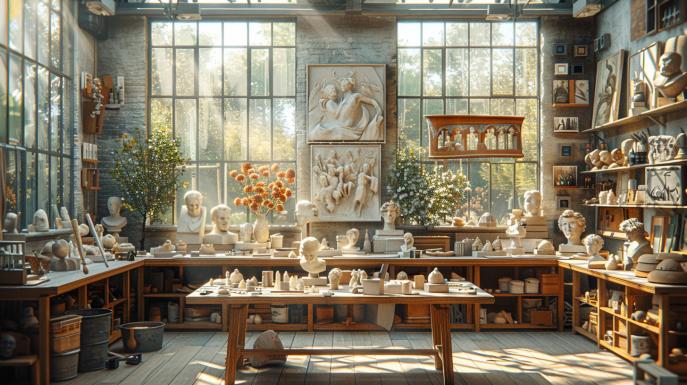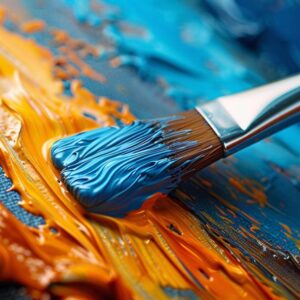Have you ever found yourself admiring the complexity and beauty of a sculpture, contemplating the possibility of creating something with your own hands? Well, diving into the world of sculpture can be more accessible than you think. With the right guidance, even beginners can model their first works with confidence. In our guide [Introduction to Sculpture: Simple Step by Step], we uncover the secrets behind getting started in sculpting, from choosing the type of clay to model with to selecting your first sculpting project. Let's not just sculpt figures, but the beginning of a transformative passion. Join us on this tactile journey and awaken the sculptor that resides within you!
How to choose the correct material to start sculpting?
When taking your first steps in sculpture, the choice of material is decisive. For beginners, what is your suggestion? Clay is usually the ideal starting point. The reason is simple: it is a versatile material and forgives mistakes, offering the possibility to remodel and adjust as you learn.
There are several types of modeling clay, such as ceramic clay, porcelain and polymer clay. Each type has its own characteristics, such as texture and burning temperature requirements. Choosing your first sculpture project involves considering these differences. For example, pottery clay is excellent for hand modeling techniques and often requires firing at high temperatures in a ceramic kiln.
When selecting a simple project to start with, envision works that don't require complex details. This will help build confidence and skill progressively. The design you choose should be something that encourages both technique and creative expression, such as a small bowl or a simplified abstract sculpture.
In addition to the type of clay, the understanding the drying and burning process is crucial. It is necessary to prepare the piece so that it is completely dry before the so-called “biscuit firing”, followed by a possible application of glaze and a final firing, if desired.
In short, sculpture is a journey of discovery. By choosing the right material, like clay, and embracing simple projects, you'll be on your way to unlocking the limitless potential of this ancient art form, exploring not just a skill but also a form of personal expression.
What are the essential tools for carving?
When starting out in the world of sculpture, understanding the basic set of tools is essential. To the carving tools They are like extensions of the artist, allowing them to shape and bring their vision to life. Now, the question is: what are these crucial tools for a beginner?
To the clay modeling, basic tools include clay wire cutters, tape tools, lasso tools It is wood shaping tools. Each one has specific functions, such as removing excess, sculpting fine details and smoothing surfaces.
If you are thinking long term and already envision improving your modeling skills, remember that attention to the care and maintenance of your tools will be a key aspect. Cleaning after each use and proper storage ensure its durability and accuracy.
In the case of larger sculptures, a armature made of wood or metal is essential, serving as an internal support for your work. This provides the necessary structure to hold the clay and other materials while you work.
In addition to clay, it is interesting to note how to use wooden tools in modeling offers a differentiated tactile experience. Choosing quality materials will make a difference when working with wood or stone, requiring slightly more robust tools, such as chisels, hammers and scrapers.
Reflecting on Alexander Calder and his sculptures, you realize that the right tools can transform simple materials into shapes that capture movement and emotion. Therefore, beginners should embrace the process of discovering the right tools, always remembering to keep an eye on safety and the correct technique to avoid accidents.
With these instruments in hand, you have more than the basics to begin modeling your first works and exploring the valuable art of sculpture. The journey is full of learning and your first steps are crucial in defining your path in this artistic field.
What are the basic modeling techniques for beginners?
When taking your first steps into sculpture, it is vital to start with the basic sculpting techniques which are fundamental to building a solid understanding of the environment. Two essential techniques for any aspiring sculptor are the coiling (rolls) and slab (plates). By creating forms in clay using these methodologies, even those just starting out are able to sculpt works with structure and form.
Coiling (Roll)
Coiling consists of rolling strips of clay to build containers, vases or other shapes. It essentially begins by making clay rolls, similar to snakes, and progressively joining them in a spiral or in overlapping layers. This technique allows you to build pieces with walls that range from as thin to as thick as you wish, giving you great freedom to express your creativity.
Slab (Plate)
The slab technique is used to create geometric or organic shapes from clay slabs that are cut and assembled. The clay is rolled out with a roller until it is the desired thickness, and then it is cut into shapes that are joined at the edges to form the sculpture. This approach is excellent for creating flatter or volumetric structures and is often used to craft objects such as boxes and bowls with a more angular design.
When it's about sculpture tutorials for beginners, the internet is full of visual resources and step-by-step instructions that can be extremely helpful. One free image resource, for example, can offer inspiration and a visual reference point for your first work.
Essential advice for molding your first clay sculpture includes keeping the clay moist to prevent cracking during modeling. Additionally, you need to understand how to avoid cracks and breaks when drying and baking the clay, as these are critical steps in the sculpting process. The work must be allowed to dry slowly and evenly to prevent cracking before the first firing, known as 'biscuiting'. Then, the piece must be fired in a ceramic kiln at the appropriate temperature for the chosen type of clay.
By following these simple steps and applying coiling and slab techniques, you are well on your way to successfully modeling your first works and exploring your creative potential in the ancient art of sculpture.
How to transform your ideas into sculpture?
Turning ideas into sculptures is a rewarding process that begins long before we touch a piece of clay or excavate the first splinter of wood. It is the act of giving shape to the intangible, a challenge that requires both creativity and technical understanding. But where to start? The development of a sculptural work begins with the conception of its concept and the creation of sketches.
When sketching, there is no need to be a drawing master. The important thing is to capture the essence of what you want to express. These visual representations serve as a guide to explore dimensions, proportions and even the narrative that the sculpture will tell. By studying basic proportions and shapes, we begin to understand how light and shadow interact with different volumes, fundamental knowledge for creating convincing three-dimensional works.
And what would it mean to learn to see the world through the eyes of a sculptor? It is developing an analytical look at the forms around us; it's about seeing beyond the surface, appreciating contours, textures, and how elements come together into a cohesive whole. This critical look is what allows us to transform inspiration into arts and artistic concepts into sculpture, making the works unique and true extensions of our being.
Among the multiple media available, for beginners clay is often suggested due to its forgiving nature and versatility. With it, it is possible to experiment and make mistakes without major consequences, improving skills as we shape. As it is a malleable and easy-to-work material, it allows ideas to be quickly tested and forms, created and recreated with few barriers.
We invite you for a broader view of this ancient and accessible art; visit this gallery to get inspired and start bringing your artistic visions to life.
How and where to seek inspiration and improvement in sculpture?
Sculpture is an ancient art form that remains relevant to this day, inspiring and shaping not only materials, but the artist's own trajectory. For those just starting out, facing the challenge of finding inspiration and paths to improvement can seem like an arduous task. However, there is a universe of possibilities waiting for the beginning sculptor.
Visits to museums and galleries are the ideal starting point. Direct observation of works created by past masters and renowned sculptors allows for learning that goes beyond the technical. The proportions, textures and narrative behind each piece can offer precious insights and spark your own creative impulse.
For newcomers to the fascinating world of sculpture, participating in beginner sculpture workshops and courses can be an excellent way to learn fundamental techniques and begin shaping their first works. These courses provide not only practical knowledge, but also an environment conducive to debate and exchange of experiences between peers, which is essential for artistic growth. And, in times of digitalization of art and learning, there is a range of online courses available, which offer flexibility to fit into the most diverse lifestyles.
And how can you bring the sculptural community to life in your daily life? Joining communities and finding mentorship becomes more accessible when you actively engage in interest groups, online forums, and arts events. Having someone to guide your first steps or simply fellow sculptors with whom you can share ideas and challenges can accelerate your evolution. Furthermore, interaction continues to be an inexhaustible source of inspiration – each artist has a unique story to tell, each sculptural piece bears the mark of its creator.
Dive into the sculptural journey with an open mind and a heart willing to learn and share, as can be stated by School Connection, and you will discover that the act of creating with your hands goes beyond technique; It's a way of connecting with yourself and the world around you.
Introduction to Sculpture: Simple Step by Step
When entering the world of sculpture, one of the crucial points for a beginner is choosing the appropriate material. What are the recommended materials for beginners? Clay stands out as the recommended choice thanks to its forgiving nature and versatility. It allows the beginner to explore and learn without the immediate need for complex tools.
But what is the difference between the types of clay? Clays vary mainly in terms of firing temperature and durability. We have ceramic clay, which includes earthenware, stoneware and porcelain; and polymer clay, which does not require a special oven. Each offers different experiences, and it is crucial to consider the specificities of the project in question.
How to select a simple project to start with? Looking at projects that allow you to practice fundamental techniques, such as freehand modeling or using rollers and plates, can be a great starter. Opting for basic shapes and small sculptures allows the beginner to gradually improve their skills. Ideally, focus on the creative process and technical aptitude before moving on to more ambitious projects.
For those eager to begin this artistic journey, visit this collection of images, which can serve as inspiration when observing the diverse creative possibilities of sculpture. As you explore these images, imagine which of the shapes depicted there resonates most with you. Which one calls you to give life through the art of sculpture?
When delving into this expressive ancient art form, it's valuable to remember that regardless of the materials or tools you choose, what matters most is your personal connection to the work, and how it reflects your growth and worldview. Believe in your first creations, as they are the ones that will lay the foundations of your sculptural journey.
In this article, we explore the first steps of sculpture, with special attention to materials and tools suitable for beginners, essential for bringing your three-dimensional ideas to life. We explore basic modeling techniques, glimpse the process of turning inspiration into reality, and emphasize the importance of seeking inspiration and continuous improvement. Sculpture is, without a doubt, a vast and rewarding field. Starting this journey, you not only create shapes, but you also sculpt a new vision of the world, which is reflected in each work shaped by your hands. May this introduction be the starting point for works that express your uniqueness and passion for the art of sculpture.
FAQ
Common questions
What is the best material for carving beginners?
Clay is the most recommended material for sculpture beginners. Its versatile and forgiving nature allows the sculptor to learn and adjust the work easily.
What are the main tools needed to sculpt clay?
Basic tools for clay modeling include wire cutters, ribbon tools, lacing tools, and wood modeling tools. Each one has specific functions to improve the sculpting technique.
Which modeling techniques are best suited for beginners?
The coiling (rolls) and slab (plates) techniques are fundamental for beginners, allowing the creation of pieces with different structures and shapes, which helps in the development of basic sculpting skills.
How can a beginner turn their ideas into sculpture?
Beginners can start by sketching their ideas to capture the essence of what they want to express, then using materials like clay to experiment and shape their artistic visions.
How to find inspiration and improve your sculpting skills?
Inspiration and improvement can be found by visiting museums, participating in sculpture workshops and courses, as well as engaging with arts communities and events, allowing for a continuous exchange of experiences and learning.





